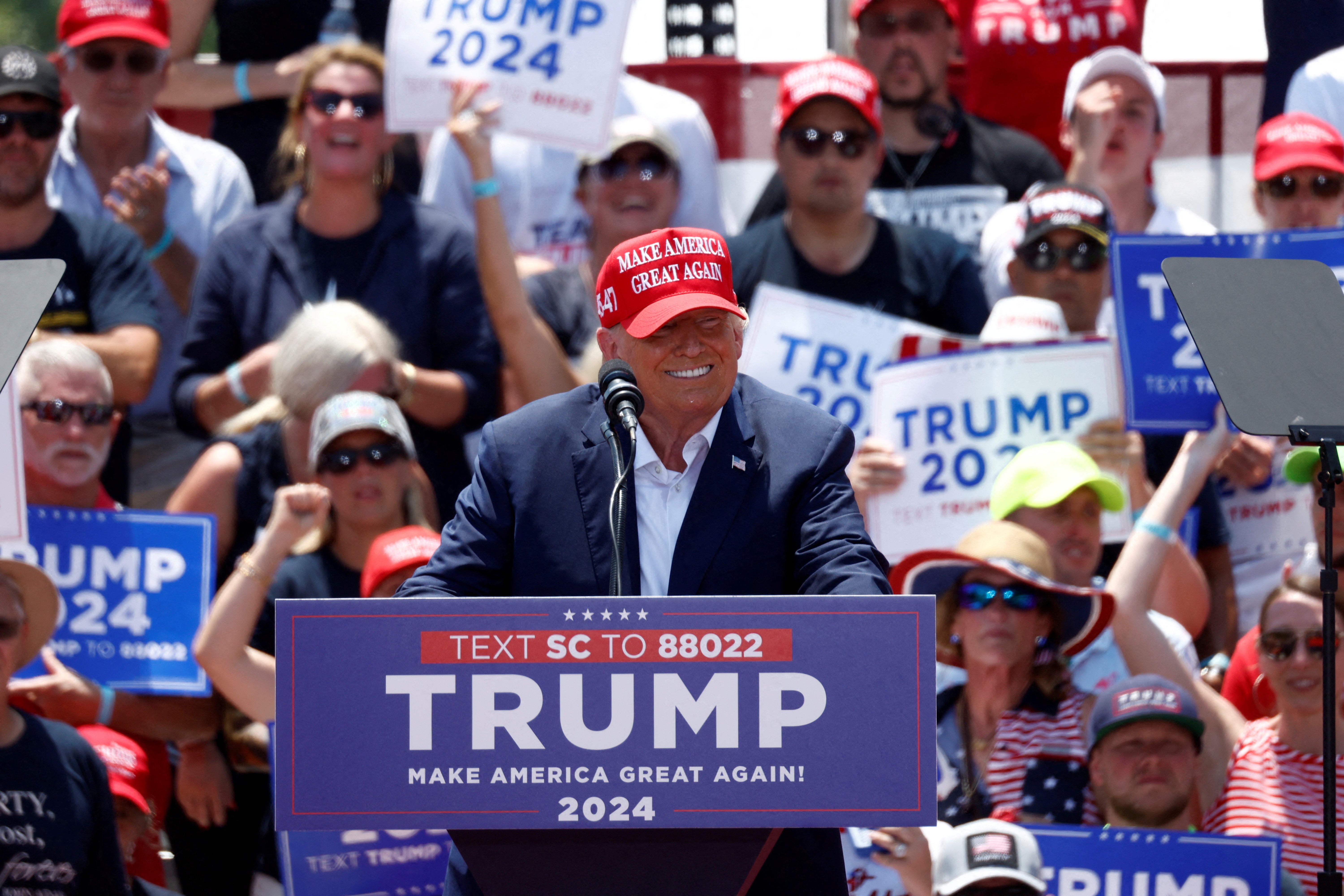What putting Trump back in the White House would mean for Ukraine – and conflict in the rest of the world
The former president has made his views on Nato clear, writes Mary Dejevsky. So what happens if he wins in 2024 – and the war isn’t over?


Joe Biden’s visit to the UK this weekend, when he will meet the prime minister and the king, could serve as a welcome reminder about where political power – and responsibility – currently resides on both sides of the Atlantic.
I say this, because some of the recent running on arguably the most urgent international issue of the day has been made by someone who has no power whatever, but eyes a return. Step forward (as if he needed any invitation to do so) Donald Trump, who spoke at some length this week about wanting a peaceful outcome in Ukraine, even if this entailed territorial concessions on the part of Kyiv.
“I think the biggest thing that the US should be doing right now is making peace,” he said, “getting Russia and Ukraine together and making peace. You can do it.” Suggesting that Russia’s president had been somewhat weakened by the mercenary-led mutiny last month, Trump said: “This is the time to do it, to get the two parties together to force peace.”
Trump was expanding on remarks he had made at a New Hampshire town hall meeting in May, where he had controversially refused to commit himself to a Ukrainian victory, saying: “They’re dying. Russians and Ukrainians. I want them to stop dying...” and suggesting that, if ending the war were left to him, he would have it “done in 24 hours”.
By accident or design, Trump’s interview came just before the Nato summit, which takes place next week in the Lithuanian capital, Vilnius. President Biden’s visit to London is essentially a stopover on the way to this meeting and doubtless a chance for the US and the UK to smoothe away any possible differences before a summit where cast-iron unity is seen as a prerequisite.
One source of potential discord has been removed with the decision that Jens Stoltenberg should remain secretary general for another year. A contest, in which the UK defence secretary, Ben Wallace, had been seen as a contender, has thus been avoided. Intense efforts have also been applied to defusing another disagreement: on Nato membership for Ukraine.
Many East and Central European members want Ukraine to be admitted as soon as the war is over, or sooner. Others, including the United States, are more circumspect. How difficult an issue this is can be judged by the fact that opinion seems only now to be coalescing around the idea of specific security guarantees, with some arguing that these offer more effective reassurance in the short term, while others – including Ukraine itself – want nothing short of the Nato “nuclear umbrella”.
Either way, the imperative is to signal at once reassurance to Ukraine and determination to Russia that Nato will stand with Ukraine for the duration. And several currents flow underneath these positions.
One is a concern not to repeat what many see as the error of the Bucharest summit in 2008. A profound disagreement about whether Georgia and Ukraine should be offered a pathway to membership was papered over with a form of wording that, to some, meant a guarantee of Nato membership one day, just not now, and, to others, meant nothing of the kind. This had the effect of leaving Georgia and Ukraine in a so-called “grey zone”, neither in, nor out, of Nato.
The conventional wisdom, in the east of Europe, at least, is that if these two countries had been offered a pathway to membership, Ukraine would have been a member by now and avoided the Russian invasion. The counter-argument, and the reasons for reluctance at the time, was, first, that these countries were a long way from being ready for membership and that, second, admitting them could precipitate a military response from Moscow.
As it happens, both views can be seen as vindicated by what has happened since, which connects to another potential division that has to be avoided at Vilnius. While some countries seem little troubled by the notion of a war between Nato and Russia, this is not Nato’s official position. Thus far, all military and financial help to Ukraine has been provided on a bilateral basis, country to country.
This has not stopped Russia describing the conflict as a “proxy war” between the alliance and Russia, but it has allowed Nato to preserve what by now is a hair’s breadth distinction between legitimate assistance to Ukraine and an all-out Nato-Russia war. But there is another reason why the Nato countries are so keen to avoid even the slightest appearance of division at Vilnius, and this takes us back to Donald Trump and the calendar for 2024.
When Nato convenes this time next year, as is planned, to celebrate its 75th anniversary in Washington DC, the political scene on either side of the Atlantic could look quite different. The UK will be even closer to an election campaign – if the election has not already taken place – with the likelihood, as it would appear now, of a Labour victory. And the US will be weeks away from the major party conventions that will endorse the two individuals most likely to fight it out for the presidency.
The consensus is that the war in Ukraine will not be over by then, with the possibility that it becomes a US election issue, along with the US commitment to the defence of Europe, the place of Ukraine in the Western bloc and who pays the likely trillion-dollar-plus bill for post-war reconstruction.
Given Trump’s known views on Nato (that the Europeans should be paying a lot more for their defence), on the war in Ukraine (that it is “ridiculous” and that he could end it tomorrow) and on some broad lines of US foreign policy (that China is the main threat, while he could talk to Russia), it is understandable that the alliance should want to “lock in” the current position. This includes the United States being committed to the security of Europe, Nato de facto protecting the security of Ukraine and promising membership to Ukraine one day – and Russia as a permanent threat.
A Trump presidency, even a Trump candidacy, could derail these certainties, and encourage those Americans who already have qualms about the extent of support for Ukraine to speak more loudly. This is where, of course, Trump’s old adversaries would return with attempts to label him a “Putin-ophile” and a reprise of the Russia-gate saga that so hobbled his presidency last time around.
Whether the accusations would have the same effect, however, could be another matter, if they held the promise of the US staying out of European quarrels and an end to the Ukraine war. Indeed, Trump could argue that his Russia policy failed not because it was necessarily misguided, but because he was blocked from pursuing it by Washington.
There are also fewer differences between his policies and those of Barack Obama and now Biden than is often portrayed. As Boris Johnson recently pointed out, Trump was the first to clear weapons – Javelins – for Ukraine, a move that made it easier for the UK to supply weapons subsequently.
The notion of Trump as an all-out isolationist is wrong. He is a realist par excellence. But where detractors might see inconsistency, unpredictability and a strange proclivity to hoard secret papers, supporters might see him as nimble and flexible in response to new situations. Could Trump have prevented the Ukraine war? Maybe not, but he might not have rebuffed Moscow’s last-ditch appeal for security talks in December 2021, a rebuff key to Putin’s decision to invade.
Much, of course, could change in the next 12 months. The two candidates vying for the White House may not be the two favourites we see today. Biden’s age and Trump’s legal problems may become too much of a liability.
But if the war in Ukraine is not over, then US involvement could be in contention – and Trumpism, if not Trump himself, could prevail. Waving the flag for Ukraine is one thing; dispensing US dollars and armaments – if not American blood – is another, especially in an election year.






Join our commenting forum
Join thought-provoking conversations, follow other Independent readers and see their replies
Comments